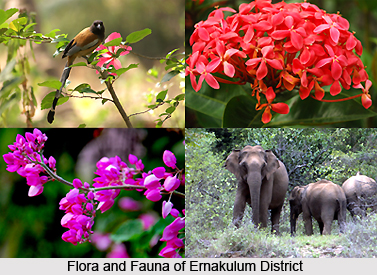The district Ernakulum has a variety of flora and fauna, which are, described below:
The flora of this District is tropical. The heavy rainfall combined with moderate temperature and fertile soil support luxuriant vegetation. In low land region, which is formed with the coastal area, are mainly filled with many of the common plants.
The midland region is mainly occupied by coconut palms. The other crops like Paddy, Tapioca, Pepper and pulses are also cultivated here. The teak and rubber cultivation is prominent in the lower slopes of the highland region.
Ernakulam District has an abundant backwater system adjoining vast areas of paddy fields, which are, subject to flood and movement of water in accordance with the draw back and flow of the tides. This condition is complimentary for the growth of large and varied fish population and aquatic birds. Monkeys, carnivorous, elephants, and ungulates represent the mammals. Whereas the others present are bats and insectivorous.
 Forests:
Forests:
The forest area is almost 8123 Hectares comprises of the Malayattoor high range and northern and northeastern tip of the Muvattupzha and Kothamangalm Taluk.
Here in this district there are tremendous natural facilities for both marine and inland fisheries offered by the Sea along the entire coast of the District and the backwaters abound in fish of various kinds. The various aspects like the education, research and development are the support to fisheries. To provide all these facilities to the fishermen Kochi is an ideal place. There are various important institutions, which are located here to serve this purpose like the Central Marine Fisheries Research Institute, The Marine Products and Export Development Authority, Central Institute of fisheries technology and Cochin University School of Marine Sciences.



















